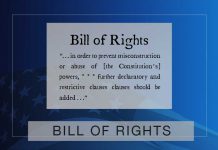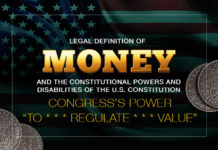Last Updated on August 20, 2022 by Constitutional Militia
“Original Intent”
“Original intent” is the fundamental rule of construction of the Constitution. In the parlance of modern constitutional exegesis, Blackstone’s phrase “intentions at the time when the law was made” has come to be truncated into the term “original intent”.[1] At the time the Constitution was written the doctrine of “original Intent” was already hundreds of years old.[2] When “WE THE PEOPLE ***ordain[ed] and establish[ed] this Constitution”[3] there was no other rule of construction known to us but “original intent”. With the passage of time came the legal sophistry of the “living” Constitution that has no fixed rule of construction, but instead is a “supreme Law” who’s meanings change in the manner of chameleon changing it’s color.
Although this website does focus on leading decisions of the Supreme Court, it also keeps foremost in mind the wisdom of Henry de Bracton, “that ignorant, confused, or power-seeking judges often misapply or subvert the laws”.[4] This observation is peculiarly pertinent today, when even Justices of he Supreme Court charge that, as to most of the Court’s decisions,
“the governing standard is * * * what might be called the unfettered wisdom of the majority of th[e] Court, revealed to an obedient people on a case-by-case basis. This is not only not the government of laws that the Constitution established; it is not a government of laws at all.”[5]
In light of this, the Constitutional Militia Organization will insist that “the supreme Law of the Land”[6] is the Constitution as written, not erroneous doctrines judges may attribute to it in their opinions.
“Original Intent”: Fundamental rule of constitutional construction.
The idea that decisions of courts are laws at all, in the sense constitutional provisions and statutes are, came into vogue only after the publication of Grey’s The Nature and Sources of Law, in 1909.[7] During the late 1700s quite a different understanding reigned. For example, Blackstone’s Commentaries[8] was the most satisfactory exposition of the law available to Americans. “At the time of the adoption of the Federal Constitution [the Commentaries] had been published about twenty years, and it has been said that more copies of the work had been sold in this country than in England, so that undoubtedly the framers of the Constitution were familiar with it”.[9] Speaking of the common law, Blackstone explained that each judge is “sworn to determine, not according to his own private judgement, but according to the known laws and customs of the land; not delegated to pronounce new law, but to maintain and expound the old”. Even in overruling precedents “where former determination is most evidently contrary to reason”, “the subsequent judges do not pretend to make new law, but to vindicate the old one from misrepresentation. For if it be found that the former decision is manifestly absurd or unjust, it is declared, not that such a sentence was bad law, but that it was not law”. “So that the law, and the opinion of a judge are not always convertible in terms, or one in the same thing; since it sometimes may happen that the judge may mistake the law.”[10] And, self-evidently, a mistake in stating the law cannot become the law, unless the law empowers error to supersede truth.
That the Founding Fathers, as well as all other legally literate Americans of their era, applied to their new supreme law this understanding of the difference between law and a mere judge’s opinion is evident from the very structure of the Constitution, which divides the national government into three coördinate, coequal Branches—one exercising “[a]ll legislative Powers herein granted”,[11] one exercising “[t]he executive Power”;[12] and one exercising “[t]he judicial Power”.[13] The Founders differentiated in categorical terms between the power to make laws (the “legislative Power[ ]), the power to “take Care that the Laws be faithfully executed”[14] (the “executive Power”), and the power to decide adventitious “Cases” and “Controversies”[15] involving the laws (the “judicial Power”). Moreover, the Constitution explicitly mandates that “[t]his Constitution, and the Laws of the United States which shall be made in Pursuance thereof; and all Treaties made, or which shall be made, under the authority of the United States, shall be the supreme Law of the Land”.[16] No mention is made of judgements, decisions, opinions, and least of all interpretations of the Supreme Court (or of any court) as being part of this “supreme Law”—or being any kind of law at all—let alone as controlling the construction of the Constitution as everyone else in the world, including the other two coördinate, coequal Branches of the national government. Indeed, as James Madison pointed out in The Federalist No. 49, “[t]he several departments [of the national] government] being perfectly coordinate by the terms of their common commission, neither of them, it is evident, can pretend to an exclusive or superior right of settling the boundaries between their respective powers”.
In addition, even with respect to their power to convince by dint of reason (as opposed to the power to control legally), judicial interpretations of the Constitution would not be metaphorically “law” unless they are manifestly correct. As the Supreme Court itself said in Marbury v. Madison,[17]
in declaring what shall be the supreme law of the land, the constitution itself is first mentioned; and not the laws of the United States generally, but those only which shall be made in pursuance of the constitution shall have that rank.
Thus, the particular phraseology of the constitution * * * that a law repugnant to the to the constitution is void; and that courts, as well as other departments, are bound by that instrument.[18]
Under the new Constitution in 1788, no judicial, legislative, or executive precedents existed upon which they could draw. No passage of time had then given credence to the legal sophistry that the Constitution, as supposedly a “living” document, had somehow evolved so as to take on a sense other than the one it embodied at the moment of ratification.[19]
Today, “original intent” continues as the only legitimate—indeed, the only rational—method of construing the Constitution. For, “original intent” being the rule in reliance upon which the Constitution was originally drafted and ratified, it is as much an actual, albeit only implied, provision of the Constitution as any other—indeed, perhaps more important (and certainly more often consulted) than any other, because the proper construction of every provision of the Constitution depends upon it.[20]






























